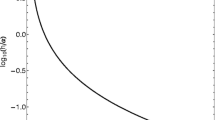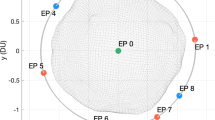Abstract
We investigate the regular or chaotic nature of star orbits moving in the meridional plane of an axially symmetric galactic model with a disk and a spherical nucleus. We study the influence of some important parameters of the dynamical system, such as the mass and the scale length of the nucleus, the angular momentum or the energy, by computing in each case the percentage of chaotic orbits, as well as the percentages of orbits of the main regular resonant families. Some heuristic arguments to explain and justify the numerically derived outcomes are also given. Furthermore, we present a new method to find the threshold between chaos and regularity for both Lyapunov Characteristic Numbers and SALI, by using them simultaneously.




















Similar content being viewed by others
Notes
We adhere to the recommended IAU symbol for year, i.e., “a” (Wilkins 1989).
A regular orbit of a \(N\)-dimensional potential obeys, by definition, \(N\) or more isolating integrals of motion. On the other hand, a chaotic orbit is defined through its sensitivity to the initial conditions in phase space: if the initial conditions of the orbit are infinitesimally displaced, then the distance between the original orbit and the new orbit grows exponentially with time. These definitions do not complement each other. Whereas it can be proved that a regular orbit is not chaotic and a chaotic orbit is not regular (e.g., Jackson 1991 Section 8.3), as far as we know it has not been proved that every irregular (i.e. not regular) orbit is chaotic, or, in other words, that every orbit obeying less than \(N\) isolating integrals has sensitivity to the initial conditions. Nevertheless, to avoid confusion, we will follow here the widespread convention of considering irregular orbits and chaotic orbits as the same set.
References
Allen, C., Santillán, A.: An improved model of the galactic mass distribution for orbit computations. Rev. Mex. Astron. Astrof. 22, 255–263 (1991)
Bennetin, G., Galgani, G., Giorgilli, A., Strelcyn, J.M.: Lyapunov characteristic exponents for smooth dynamical systems and for Hamiltonian systems; a method for computing all of them. Part 1: theory; Part 2: numerical applications. Meccanica 15(9–20), 21–30 (1980)
Binney, J., Spergel, D.: Spectral stellar dynamics. Astrophys. J. 252, 308–321 (1982)
Binney, J., Spergel, D.: Spectral stellar dynamics. II—the action integrals. Mon. Not. R. Astron. Soc. 206, 159–177 (1984)
Binney, J., Tremaine, S.: Galactic Dynamics. Princeton Univ. Press, Princeton (2008)
Caranicolas, N., Vozikis, Ch.: Orbital characteristics of dynamical models of elliptical galaxies. Celest. Mech. 39, 85–102 (1986)
Carpintero, D.D., Aguilar, L.A.: Orbit classification in arbitrary 2D and 3D potentials. Mon. Not. R. Astron. Soc. 298, 1–21 (1998)
Contopoulos, G.: In: Casati, G., Ford, J. (eds.) Stochastic Behavior in Classical and Quantum Hamiltonian Systems, p. 1–17. doi:10.1007/BFb0021732 (1979)
Contopoulos, G.: A third integral of motion in a galaxy. Z. Astroph. 49, 273–291 (1960)
Copin, Y., Zhao, H., de Zeeuw, P.: Probing a regular orbit with spectral dynamics. Mon. Not. R. Astron. Soc. 318, 781–797 (2000)
Gerhard, O., Binney, J.: Triaxial galaxies containing massive black holes or central density cusps. Mon. Not. R. Astron. Soc. 216, 467–502 (1985)
Gerhard, O., Saha, P.: Recovering galactic orbits by perturbation theory. Mon. Not. R. Astron. Soc. 251, 449–467 (1991)
Gómez, F., Helmi, A., Brown, A.G.A., Li, Y.-S.: On the identification of merger debris in the Gaia era. Mon. Not. R. Astron. Soc. 408, 935–946 (2010)
Greiner, J.: A new kind of stellar orbit in a galactic potential. Celest. Mech. 40, 171–175 (1987)
Greiner, J.: Higher order resonant orbits. Celest. Mech. Dyn. Astron. 50, 387–394 (1991)
Hasan, H., Norman, C.A.: Chaotic orbits in barred galaxies with central mass concentrations. Astrophys. J. 361, 69–77 (1990)
Hasan, H., Pfenniger, D., Norman, C.: Galactic bars with central mass concentrations—three-dimensional dynamics. Astrophys. J. 409, 91–109 (1993)
Irrgang, A., Wilcox, B., Tucker, E., Schiefelbein, L.: Milky way mass models for orbit calculations. Astron. Astrophys. 549, A137 (2013)
Jackson, E.A.: Perspectives of Nonlinear Dynamics. Cambridge Univ. Press, Cambridge (1991)
Kalapotharakos, C., Voglis, N.: Global dynamics in self-consistent models of elliptical galaxies. Celest. Mech. Dyn. Astron. 92, 157–188 (2005)
Karanis, G.I., Caranicolas, N.D.: Transition from regular motion to chaos in a logarithmic potential. Astron. Astrophys. 367, 443–448 (2001)
Laskar, J.: Secular evolution of the solar system over 10 million years. Astron. Astrophys. 198, 341–362 (1988)
Laskar, J.: Frequency analysis for multi-dimensional systems. Global dynamics and diffusion. Phys. D 67, 257–281 (1993)
Lees, J.F., Schwarzschild, M.: The orbital structure of galactic halos. Astrophys. J. 384, 491–501 (1992)
Manabe, S.: Applicability of approximate third integral of motion for stellar orbits in the galaxy. Publ. Astron. Soc. Japan 31, 369–394 (1979)
Manos, T., Skokos, Ch., Athanassoula, E., Bountis, T.: Studying the global dynamics of conservative dynamical systems using the SALI chaos detection method. Nonlinear Phenom. Complex Syst. 11, 171–176 (2008)
Manos, T., Athanassoula, E.: Regular and chaotic orbits in barred galaxies—I. Applying the SALI/GALI method to explore their distribution in several models. Mon. Not. R. Astron. Soc. 415, 629–642 (2011)
Martinet, L., Mayer, F.: Galactic orbits and integrals of motion for stars of old galactic populations. III—conclusions and applications. Astron. Astrophys. 44, 45–57 (1975)
Meyer, K.R., Hall, G.R.: Introduction to Hamiltonian Dynamical Systems and the N-body Problem. Springer, Berlin (1992)
Miyamoto, M., Nagai, R.: Three-dimensional models for the distribution of mass in galaxies. Publ. Astron. Soc. Jpn. 27, 533–543 (1975)
Ollongren, A.: Theory of stellar orbits in the galaxy. Ann. Rev. Astron. Astrophys. 3, 113–134 (1965)
Ollongren, A.: Construction of galactic stellar orbits similar to harmonic oscillators. Astron. J. 72, 436–442 (1967)
Press, H.P., Teukolsky, S.A., Vetterling, W.T., Flannery, B.P.: Numerical Recipes in FORTRAN 77, 2nd edn. Cambridge Univ. Press, Cambridge (1992)
Šidlichovský, M., Nesvorný, D.: Frequency modified Fourier transform and its applications to asteroids. Celest. Mech. Dyn. Astron. 65, 137–148 (1996)
Skokos, Ch., Antonopoulos, Ch., Bountis, T.C., Vrahatis, M.N.: Detecting order and chaos in Hamiltonian systems by the SALI method. J. Phys. A: Math. Gen. 37, 6269–6284 (2004)
Szydlowski, M.: Curvature of gravitationally bound mechanical systems. J. Math. Phys. 35, 1850–1880 (1994)
Wilkins, G.A.: The IAU Style Manual, in IAU Transactions XXB, p. S23 (1989)
Zotos, E.E.: Trapped and escaping orbits in an axially symmetric galactic-type potential. Publ. Astron. Soc. Aust. 29, 161–173 (2012a)
Zotos, E.E.: Exploring the nature of orbits in a galactic model with a massive nucleus. New Astron. 17, 576–588 (2012b)
Acknowledgments
The authors would like to thank the anonymous referee for the careful reading of the manuscript and for all the aptly suggestions and comments which allowed us to improve both the quality and the clarity of our work. This work was supported with grants from the Universidad Nacional de La Plata (Argentina), the Consejo Nacional de Investigaciones Cientí ficas y Técnicas de la República Argentina, and the Agencia Nacional de Promoción Científica y Tecnológica (Argentina).
Author information
Authors and Affiliations
Corresponding author
Rights and permissions
About this article
Cite this article
Zotos, E.E., Carpintero, D.D. Orbit classification in the meridional plane of a disk galaxy model with a spherical nucleus. Celest Mech Dyn Astr 116, 417–438 (2013). https://doi.org/10.1007/s10569-013-9500-0
Received:
Revised:
Accepted:
Published:
Issue Date:
DOI: https://doi.org/10.1007/s10569-013-9500-0




